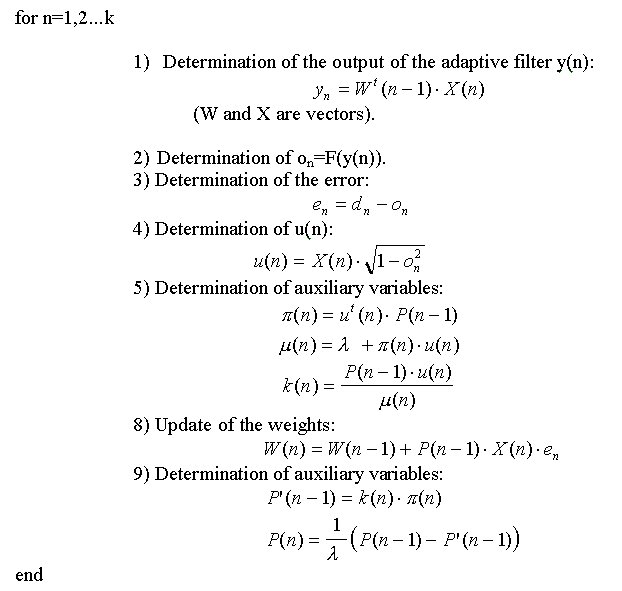Poster | 6th Internet World Congress for Biomedical Sciences |
Marcelino Martinez_Sober(1), EMILIO SORIA OLIVAS(2), Antonio J. Serrano López(3), Alfredo Rosado(4), José David Martín Guerrero(5)
(1)Universidad de Valencia - Burjassot. Spain
(2)DPTO INGENIERÍA ELECTRONICA. FACULTAD DE FISICAS - BURJASSOT/VALENCIA. Spain
(3)Dpto. Electrónica. Universidad de Valencia - Burjasot. Spain
(4)Departamento de Electrónica. Universidad de Valencia - Burjassot. Spain
(5)G.P.D.S. Departament d´Enginyeria Electrònica. Universitat de València - Burjassot. Spain
|
|
|
|
|
|
|
[New Technology] |
[Cardiolovascular Diseases] |
[Obstetrics & Gynecology] |
Most adaptive systems currently available are based on FIR filters due to its simplicity and stability. Nevertheless, these systems are unable to achieve an optimal performance in applications with a heavy non-linear component. Another problem adds when these adaptive systems are applied to separate a series of elements in a given set of classes, as the linear output of adaptive systems is not the fittest for these applications. To overcome this limitation while maintaining the advantages of the FIR filters, the structure given in figure 1 is proposed, where F(y) is a non-linear function. Thus, in a system identification problem where the unknown system is non-linear, the precision of the adaptive system will increase. This approach entails a reduction in the computational burden of other solutions such as Volterra filters (1) as the type of the filter remains unchanged and only its output is modified with a simple function. Another advantage of this structure is that it p
resents a much shorter learning time than neural networks, so it can be applied to real-time applications such as echo cancelling on a communication link, channel equalisation, etc. To adequately solve this type of problems, a recursive learning algorithm is also proposed, as this type of procedures are much faster than those based on the gradient.
To derive the proposed algorithm, we follow a procedure analogous to the one described by Rumelhart (2). According to his approach, the non-linear function applied to the output of the filter is conditioned by the application to binary classification given to the system. Rumelhart finds an expression for the probability of getting a set of outputs, d, from the different inputs, x:
 [1]
[1]
If we consider the logarithm of the previous expression the cross entropy between the output of the system and the desired signal is obtained (2). The output and desired signals used by Rumelhart have a range from 0 to 1, as in the proposed system, these signals vary from -1 to +1, a change in the variables must be performed. Considering the new variables we obtain a new expression for the conditioned probability given by
 [2]
[2]
that, after some processing, leads to:
 [3]
[3]
and, by defining:
 [4]
[4]
where yj is the output of the adaptive filter (yj=W(j)×xt(j) ), so:
 [5]
[5]
we have, thus, derived a procedure to calculate Oj. By replacing this result in expression [3]
we get to:
 [6]
[6]
Our aim is to maximise the natural logarithm of the previous function (maximum likelihood) with respect to the filter coefficients W(j), in order to obtain the maximum probability for obtaining the outputs, d, from the inputs, x. An iterative method to solve this problem is the Newton-Raphson (3):
 [7]
[7]
By calculating the forementioned derivatives we obtain:
 [8]
[8]
 [9]
[9]
If we define a new variable:
 [10]
[10]
 [11]
[11]
then, the second derivative can be recursively obtained, as:
![]() [12]
[12]
and we can apply the matrix inversion lemma (4) which is the basis of recursive algorithms.
This procedure presents a major drawback when we approach the optimum system as the gradient term does not vanish because it considers all contributions from the beginning of the iterations and that involves a continuous adaptation of the weights. The easiest solution is to consider only the last term of the summation that yields the expression of the gradient.
The obtained algorithm is like it continues:
Initialization of the variables, P(0),W(0), with P(0) similar to d-1×I (being I the main identity and d a very small value).

The proposed algorithm has been tested for the extraction of the foetal ECG (FECG), by removing the interference of the dominant maternal ECG component. This is a typical application of adaptive filtering as the spectra of both signals, desired and noise, are overlapped and a frequency selective filtering would distort the desired signal, i.e. the FECG. The scheme of an adaptive noise canceller is in fig. 2
Signals are supposed to vary from ±1 so, before applying the algorithm, be must normalise them by the maximum value and removing their mean value. The first fetal signals used in this test have been obtained with a simulator (5). fig. 3 shows the original fetal signal and an abdominal maternal electrocardiogram. In figure 4 fig. 4 we show the outcome of applying a basic LMS with an adaptation constant of 0.2 and the proposed algorithm, clearly noting a minor distortion in the signal obtained by the new method.
Results of the second group of simulations, where we use real foetal registers are shown in figure 5 fig. 5 and figure 6 fig. 6.
Adding a non-linear stage at the output of the basic LMS improves its performance in applications such as binary classification and system identification. The bottleneck of this approach is its low velocity of convergence. To increase it, a new recursive learning algorithm based on Rumelhart´s procedure (2) is proposed. The performance of the system is shown in an application that pursues the extraction of the fetal ECG from maternal surface abdominal recordings. The outcome of the filtering favourably compares to the basic LMS with the added advantage of not requiring any adaptation constant.
|
|
|
|
|
|
|
[New Technology] |
[Cardiolovascular Diseases] |
[Obstetrics & Gynecology] |